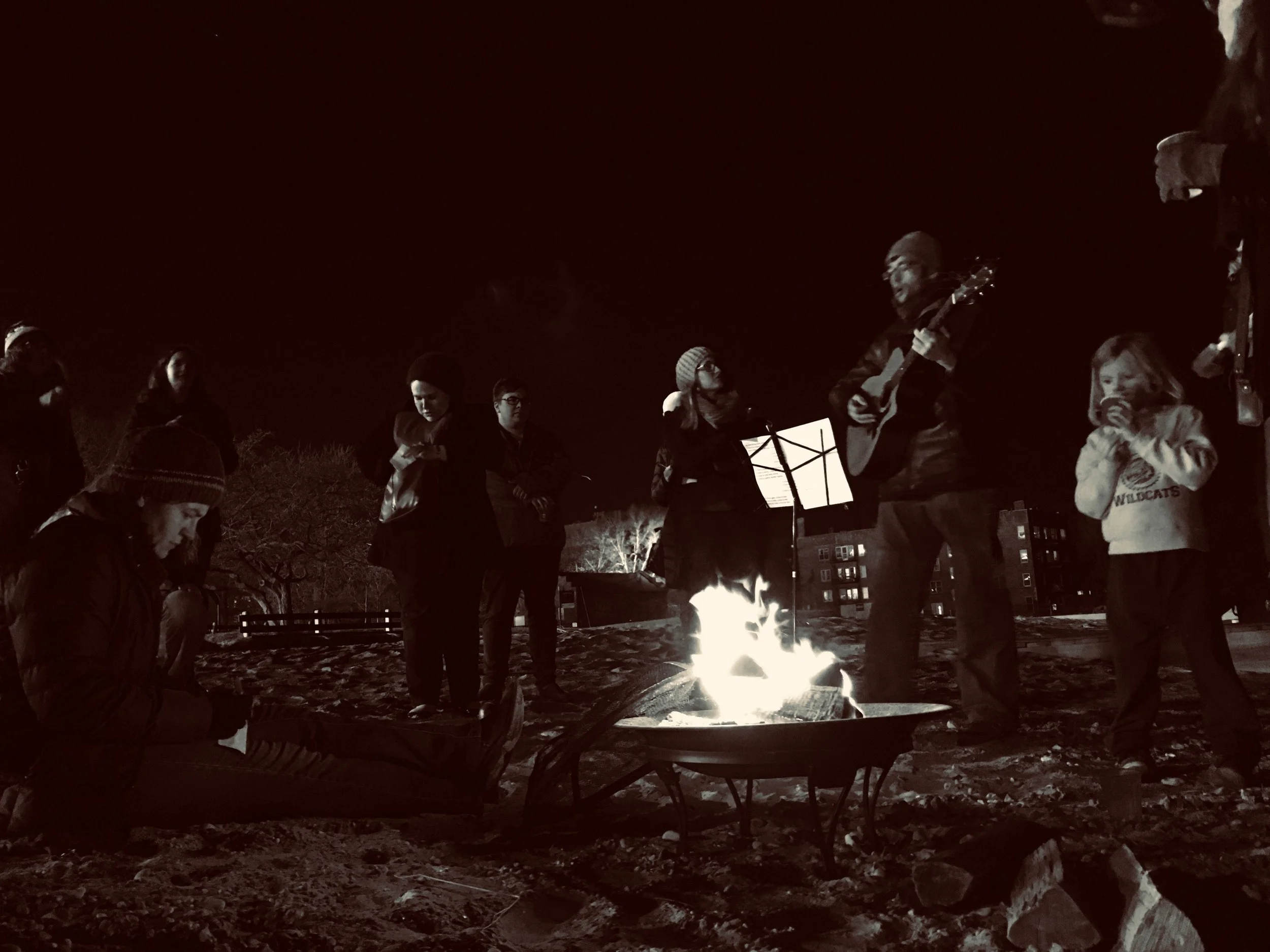Issue date: June 1st, 2019. Christopher Piatt asked Rev Rebecca Anderson to come tell The Paper Machete what the bible has to say about abortion. Below is her response.
On Wednesday, Season 3 of The Handmaid’s Tale drops. Big news for anyone who enjoys long close-ups of Elizabeth Moss’s eyes batting frantically as she confronts the horrors of what we, until recently, enjoyed thinking of as dystopian fiction. Now, of course, the plot cuts a little close to the bone as a decades-long plan to overturn Roe v Wade unfolds faster and faster.
The new season of The Handmaid’s Tale is of particular interest to me because a few years ago I started a new congregation, a queer, storytelling, bar church. We had a dreamy, weird little vision, not un-inspired by the Paper Machete, actually — and we named it Gilead. Our Gilead had been meeting for a few months, our Gilead website live for a year, a successful kickstarter for our Gilead under our belts when I said to my co-pastor, “I’m excited. Hulu’s coming out with a new Handmaid’s Tale.”
“Yeah,” he said. “Do you remember the name of the regime — “
Fuckkkk.
When Margaret Atwood wrote The Handmaid’s Tale, she had a rule for herself: she “would not include anything that human beings had not already done in some other place or time, or for which the technology did not already exist.” So that the Republic of Gilead — that’s the name of the regime — feels familiar and possible isn’t an accident: the group hangings, the forbidding of literacy for women, the theft and removal of children from parents for placement with those in power, the forced childbearing and the appropriation of children born as a result, these all have precedents not in “other” cultures and religions, Atwood wrote, but “within Western society, and within the ‘Christian’ tradition itself.”
So it’s of particular interest to me not just because of the truly great cinematography or because of how often someone in a bar says to me, “Hey, funny question: do you watch The Handmaid’s Tale?” (as if I don’t know), but because the book, the show, and our own current reality is rooted in a faith tradition that, sure, I could’ve left but didn’t.
* * *
Here’s the thing: the Bible doesn’t say anything about abortion. Miscarriages get just two mentions: once, it’s not a crime; once, it’s a source of grief. There are lots of people who get pregnant in the Bible, there are a bunch of people who really want to get pregnant but can’t. There are lots of miraculous pregnancies — post-menopausal women getting pregnant and, famously, Mary, the mother of Jesus. There are a couple of bad-ass midwives in the book of Exodus who, when told to control a population of enslaved people by killing their baby boys when they’re born, look the Pharaoh in the eye, use his racism against him, and say, “These Hebrew women, they’re so hardy that we can’t get there fast enough when they give birth.” There’s a woman who tricks her father-in-law into fucking, for the sake of justice. There’s at least one woman who trades fruit for sexual favors, trying to get knocked up. There are women “giving” their maids to their husbands. There’s abuse and sexual assault and grief and hope against hope for a future when no people will be enslaved, when the work of laborers will profit them and not the oppressors, when children will not be born for calamity. That last is Isaiah 65 if you’re following along in your bibles.
The thing about the bible is that it doesn’t say anything on its own, without interpretation, I mean. And, as a man on a Tinder date with me will tell you, even though I have an advanced degree in religion and he does not: read in the right light, the Bible is actually quite radical.
* * *
In May of 1967, the front page of the NYTimes ran a little article announcing the formation the Clergy Consultation Service. A group of 21 clergy people, ministers and rabbis, were available for abortion advice. Rev Howard Moody was the senior minister at Manhattan’s Judson Memorial Church, and he traveled the country, having private conversations with pastors in their homes and church basements, pulling together a coalition. At the end of that first year, there were about 1400 members of an underground clergy network. They offered a phone number to call, that was answered by a recording of a woman’s voice. She listed clergy, their locations, and how to reach them. Then, once you, pregnant, were sitting in a rabbi or pastor’s office, they’d ask what you wanted to do. If the answer was abortion, they’d help you get one safely.
There was a university chaplain in St Louis, Rev William Kirby, who estimates that he personally helped 3000 women. They got on a morning flight to New York — lawyers advised it was harder to prosecute out-of-state procedures — and were back in the dorm by nightfall.
Arlene Carmen, a church administrator who definitely would’ve been called a church secretary, went to doctors who offered abortion, posed as a pregnant client, and assessed the place for everything from sterile instruments to kind staff. She sometimes waited until she was in the stirrups to reveal her identity and purpose. Other women did the same.
Rev Barbara Gerlach, whose friend had gotten a back-alley abortion from a man who wore a mask from the moment he met her at the door through the entire procedure, entered seminary in 1968. By the time Rev Gerlach was ordained, she could help women go to New York State for legal abortions. “We had pastoral confidentiality,” she said. “We could talk to women in a way that our conversations were privileged. And I thought ‘Well, this is something I can do. I can help women.’”
Congregations pitched in to defray costs of travel and treatment. Clergy used their discretionary funds to help. The Consultation Service got big enough — up to about 3000 clergy, by some counts — that they had economic leverage and convinced providers to keep costs low or even waive fees.
One of things the bible says, read in a certain light, is that God is on the side of the vulnerable. Always. For anti-abortion people, this means that God is on the side of fetal tissue. But the bible is silent on that matter. What the bible does say, at great length, over and over, in many ways, is that failure to care for neighbor, stranger, widows, orphans, the impoverished, the reviled, is one of the quickest ways to incur God’s wrath. A phrase I did not imagine saying at the Paper Machete.
The Clergy Consultation Service recognized that, as now, laws concerning abortion unduly impacted poor women, and women of color. If you could afford it, a doctor would deem your abortion “therapeutic” and sha-zam: you got a legal abortion. The way the consultation service read it, that was just one more instance of the powerful getting their needs met while the vulnerable suffered.
The pastors and lay leaders in the Clergy Consultation Service understood that an unwanted pregnancy is an affliction. Very bible-y language. And their call, in light of that, said Rev Robert Hare, was natural: it was to ease the affliction. Their call was to offer compassion.
* * *
Yesterday, the last clinic in Missouri to provide abortion got a few days’ breathing room; a judge granted the clinic a little more time to resolve its issues with the state. Or, the state’s issues with it. Now the clinic has until Tuesday. Phew – big relief. Now there’s plenty of time for everyone to get all the health care they need over the weekend. The clinic’s in St Louis, where Rev Kirby helped all those women get on flights to New York, 50 years ago.
Late last night down in Springfield, the Illinois Senate passed the Reproductive Health Act. Already passed by the House of Reps, it’s heading to Pritzker for his signature. And the anti-abortion faction is losing their shit. One headline joked that in Illinois, we’re making abortion a “fundamental right.” Hahaha! Can you imagine?? That just anyone could go get medical services they require? Anyway.
During the debate leading up to the passage of that Alabama bill that bans nearly all abortion without exception, the bill that sentences providers to up to 99 years in prison?, the bill’s sponsor, Alabama state senator Clyde Chambliss said that we need legal guidance on when an unborn child becomes a person. That’s an ask that everyone can regret: trying to fix an unfixable point.
There is no religious consensus, on when a fetus becomes a person. (There’s no medical or scientific one either.) The Bible has nothing to say on the matter that’s not metaphorical. God created the first people and breathed a divine breath into them, animating them. In the Psalms, there’s poetry about being wonderfully made and known and loved even in utero and another one like that in Jeremiah. But none of it proves anything. And no law, sorry Clyde, would either. People will still experience one pregnancy, that needs ending, as, y’know, not a crime. And another one, lost at the same point, as a grief. One pregnancy will still be a fuck-you to someone’s father-in-law, and another the answer to prayer.
Here’s the thing: I know that to many of you, it doesn’t matter what’s in the bible. There are many ways in which what’s in the bible doesn’t matter to me either, believe it or not. What matters to me is how all this — all this text, and tradition — gets lived out. So, even though it’s a small thing, I want to apologize. It’s something I can do.
If anyone has ever suggested to you or someone you love that an abortion is something you need forgiveness for: I’m sorry.
If someone — and I know they have — has ever tried to limit your access to health care based on their own religious commitments, I’m sorry.
For people using the same religious texts that I love and am building a community around, people using those same sacred texts to justify murder of doctors? I’m very sorry.
Those people, obviously, are not my people. My people are the bad-ass midwives, and the old retired clergy from the consultation service, chuckling in their 80s about the risks they supposedly took. My people are the one who hope against hope that something better for all people is possible and worth working for.




































